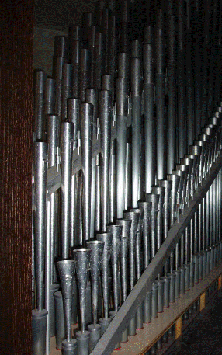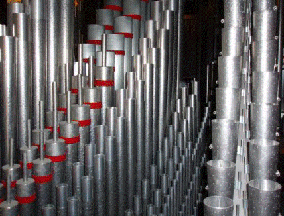Eastminster Presbyterian
Church
Eastminster Presbyterian
Church
Hearts, Hands, Heads for Christ in Service and Celebration
The Casavant Organ
The pipe organ at Eastminster Presbyterian Church was built by the pre-eminent organ building firm of Casavant Frères, Saint-Hyacinthe, Québec, Canada. The Casavant firm was founded in 1879 and has installed almost 4,000 instruments worldwide. Their instruments display superior craftsmanship and tonal beauty, attributes which have earned the firm a respected place in contemporary organ building. Op. 2970 (purchased in 1967 for $35,000) was formally dedicated on January 8, 1968, in a service and concert featuring Dr. Austin
Lovelace. Its tonal design shows the influence of the Organ Reform movement of the mid-twentieth century, emphasizing clear and colorful sounds based on classic North German historic models. The organ has two manual keyboards of 56 notes each and a pedal keyboard of 32 notes. The organ contains exactly 1,300 pipes.

The Organ In Worship
The organ’s location in the rear balcony of the Eastminster sanctuary is ideal for its most important function in worship: leading congregational singing. It also contributes to worship in several other ways:
• Accompanying choral anthems
• Accompanying vocal and instrumental soloists
• Presenting solo organ music
In addition to its vital role in Eastminster’s worship life, the organ is a vehicle for community outreach
through concerts and recitals. It is also used for teaching, in order to prepare
the next generation of organists.
Soli Deo Gloria!

Specification of the Organ
Casavant Frères, Saint-Hyacinthe, Québec, Canada
#2960, 1967
Great
Prinzipal 8
Rohrflöte 8
Oktav 4
Waldflöte 2
Mixtur IV 1⅓
Trompete 8
Pedal
Subbass 16
Spitzprinzipal 8
Choralbass 4
Fagott 16
Schalmei 4
Swell
Viole 8
Voix coelestis (TC) 8
Gedackt 8
Koppelflöte 4
Prinzipal 2
Quinte 1⅓
Sesquialtera (TC) 2⅔ Scharf III ⅔ Krummhorn 8
Tremulant
G/P, S/P, S/G, Crescendo, Tutti
Compass 56/32, electropneumatic action Chimes (25 notes) playable from Great, added 1988